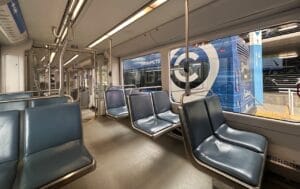‘Free’ federal money put Milwaukee on the hook for ongoing expenses; time to say ‘enough’
Milwaukee’s $128 million streetcar, the Hop — despite adding a second line — has even fewer passengers than six years ago, operates cars that are often nearly or completely empty, and stands virtually no chance of ever expanding.
It’s time to shut it down.
It’s expensive
In addition to the $128 million initial cost, my colleague Mark Lisheron reported that the City of Milwaukee is using its transportation fund’s money to plug a $4 million annual hole in the Hop’s operating budget.
City leaders have never even tried to charge riders — few would ride it at all if they did — and those annual operating costs are not going away. Expenses could easily run into the tens of millions of dollars in the years to come.
Shutting it down, granted, would be expensive as well because of all the poor decisions that have been made and Milwaukee’s reliance on federal funding.
Of the $128 million, more than $69 million initially came from the federal government in the form of a Federal Highway Administration Congestion and Air Quality Improvement (CMAQ) grant. The feds would likely make the city pay some of that back if politicians decide to finally stop running largely empty cars around downtown at all hours.
Typically, the federal government makes grant recipients in similar circumstances pay back a depreciated portion of a grant, according to Randal O’Toole, a transportation policy analyst with the Thoreau Institute. O’Toole speculates that a grant recipient for a project that shuts down after 15 years might still have to repay half the original amount, and the Hop has only been in service for less than seven.
The federal government, in other words, could make the city pay back millions, if not tens of millions.
But what’s the alternative?
Running nearly empty cars to save face for decades to come?
Ridership figures might sound okay to those who never ride it or haven’t really done the math. But, please, do the math.
Few people use it
There are actually two lines, the original M Line that runs on a 2.1-mile downtown loop, and the new L Line that, extending west from the Couture apartments on the lakefront, forms a 0.4-mile segment and intersects with the M Line.
The L Line has averaged only 165 rides a day and the M Line only 1,355 a day over the last year, according to the Department of Public Works. Both lines run an average of 18 hours a day, which means the L line has less than 10 riders per hour. I don’t know how long an average rider is on the Hop, but the whole L loop takes less than 20 minutes. Lots of riders are likely on there for maybe five or 10 minutes. That means cars on the L Line are often empty or carry one person.
I know that’s more than possible because I rode the whole L line recently over a lunch hour. There was one other passenger for maybe five minutes of the 20-minute ride. Otherwise, I was solo in a big streetcar the entire time.
The original M Line, which is five times longer, has higher ridership, but I rode that as well in the middle of a weekday and — aside from one homeless guy — there were a maximum of four riders at any given time. That’s not unusual. I know because I lived in an apartment on an M Line stop for years. I saw streetcars pass by every day that often had just a few people in a car.
The Hop gets those few people where they are going a little faster than a brisk walk would. But it also blocks traffic and frustrates drivers and prolongs red lights. Don’t take my word on it. Check out this video.
The Hop never made sense. It was built because the Milwaukee area needed to use or lose federal funding originally meant for a bus-only highway. The L Line, in particular, also doesn’t make sense — as the lack of ridership proves.
It was built because the Couture sits on the former site of a federally funded transportation center that was, in itself, a white elephant.
The transit center sat empty for a quarter-century until Milwaukee County agreed to sell it to Rick Barrett, the Couture’s developer. Only there was a catch: The Federal Transportation Administration said the locals would have to pay back over $8 million in federal money if they didn’t agree to use the site for “another (transportation) capital project” — which turned out to be the streetcar.
City leaders and county leaders should never have accepted federal money for projects that didn’t make sense. Now they’re paying the price.
And the only way to stop paying the price is to stop the Hop, try to persuade the feds to cut everyone some slack, pay up whatever the feds say would be owed, and move forward — preferably in a car or on foot or on a bus.
Speaking of buses, there was an empty one waiting right next to the L stop at the Couture when I got there, and two more that came and went while I wanted for the empty Hop to pull up.
The Hop isn’t the only game in town — just the most wasteful one.
Mike Nichols is the President of the Badger Institute.
Any use or reproduction of Badger Institute articles or photographs requires prior written permission. To request permission to post articles on a website or print copies for distribution, contact Badger Institute Marketing Director Matt Erdman at matt@badgerinstitute.org or 262-389-8239.
Submit a comment
"*" indicates required fields


